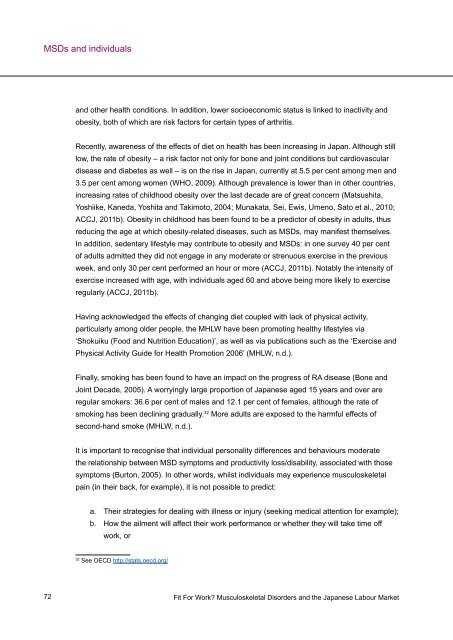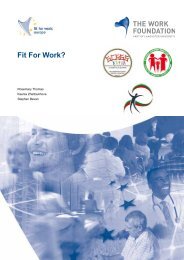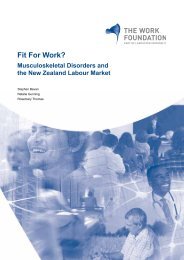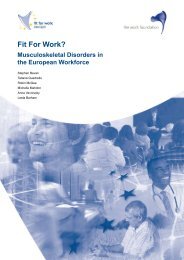English version - Fit for Work Europe
English version - Fit for Work Europe
English version - Fit for Work Europe
Create successful ePaper yourself
Turn your PDF publications into a flip-book with our unique Google optimized e-Paper software.
MSDs and individuals<br />
72<br />
and other health conditions. In addition, lower socioeconomic status is linked to inactivity and<br />
obesity, both of which are risk factors <strong>for</strong> certain types of arthritis.<br />
Recently, awareness of the effects of diet on health has been increasing in Japan. Although still<br />
low, the rate of obesity – a risk factor not only <strong>for</strong> bone and joint conditions but cardiovascular<br />
disease and diabetes as well – is on the rise in Japan, currently at 5.5 per cent among men and<br />
3.5 per cent among women (WHO, 2009). Although prevalence is lower than in other countries,<br />
increasing rates of childhood obesity over the last decade are of great concern (Matsushita,<br />
Yoshiike, Kaneda, Yoshita and Takimoto, 2004; Munakata, Sei, Ewis, Umeno, Sato et al., 2010;<br />
ACCJ, 2011b). Obesity in childhood has been found to be a predictor of obesity in adults, thus<br />
reducing the age at which obesity-related diseases, such as MSDs, may manifest themselves.<br />
In addition, sedentary lifestyle may contribute to obesity and MSDs: in one survey 40 per cent<br />
of adults admitted they did not engage in any moderate or strenuous exercise in the previous<br />
week, and only 30 per cent per<strong>for</strong>med an hour or more (ACCJ, 2011b). Notably the intensity of<br />
exercise increased with age, with individuals aged 60 and above being more likely to exercise<br />
regularly (ACCJ, 2011b).<br />
Having acknowledged the effects of changing diet coupled with lack of physical activity,<br />
particularly among older people, the MHLW have been promoting healthy lifestyles via<br />
‘Shokuiku (Food and Nutrition Education)’, as well as via publications such as the ‘Exercise and<br />
Physical Activity Guide <strong>for</strong> Health Promotion 2006’ (MHLW, n.d.).<br />
Finally, smoking has been found to have an impact on the progress of RA disease (Bone and<br />
Joint Decade, 2005). A worryingly large proportion of Japanese aged 15 years and over are<br />
regular smokers: 36.6 per cent of males and 12.1 per cent of females, although the rate of<br />
smoking has been declining gradually. 32 More adults are exposed to the harmful effects of<br />
second-hand smoke (MHLW, n.d.).<br />
It is important to recognise that individual personality differences and behaviours moderate<br />
the relationship between MSD symptoms and productivity loss/disability, associated with those<br />
symptoms (Burton, 2005). In other words, whilst individuals may experience musculoskeletal<br />
pain (in their back, <strong>for</strong> example), it is not possible to predict:<br />
a. Their strategies <strong>for</strong> dealing with illness or injury (seeking medical attention <strong>for</strong> example);<br />
b. How the ailment will affect their work per<strong>for</strong>mance or whether they will take time off<br />
work, or<br />
32 See OECD http://stats.oecd.org/<br />
<strong>Fit</strong> For <strong>Work</strong>? Musculoskeletal Disorders and the Japanese Labour Market







